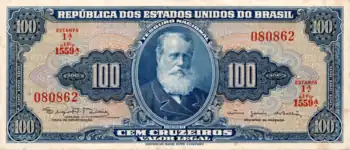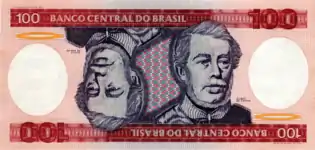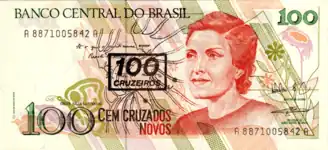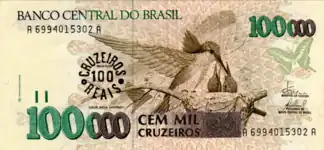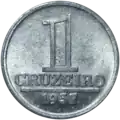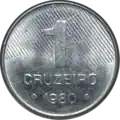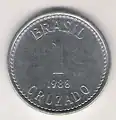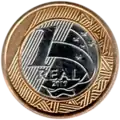.jpg.webp)
The Brazilian currency has been renamed and redefined several times through its history.[1][2][3][4][5] Since 1994, the official one is the Brazilian real (plural reais, with symbol R$ and ISO code BRL.
Historical currencies
| Introduction | Withdrawal | Duration | Name | Symbol | ISO | Conversion |
|---|---|---|---|---|---|---|
| — | — | — | Portuguese Real | Rs[lower-alpha 1] | N/A | |
| 12 October 1822[lower-alpha 2] | [7] | 120y 20d | Real (old, pl. réis) | Rs[lower-alpha 1] | = 1 Portuguese real | |
| 1 November 1942[7] | [8] | 24y 3m 12d | Cruzeiro (first) | Cr$[lower-alpha 3] | = 1,000 réis | |
| 13 February 1967[8] | 30 June 1972[10] | 3y 3m 2d | Cruzeiro novo | NCr$[lower-alpha 3] | = 1,000 cruzeiros | |
| 15 May 1970[10] | 15y 9m 12d | Cruzeiro (second) | Cr$[lower-alpha 3] | BRB | = 1 cruzeiro novo | |
| 27 February 1986 | 2y 10m 19d | Cruzado | Cz$ | BRC | = 1,000 cruzeiros | |
| 15 January 1989 | 1y 2m 1d | Cruzado novo | NCz$ | BRN | = 1,000 cruzados | |
| 16 March 1990 | 3y 4m 15d | Cruzeiro (third) | Cr$[lower-alpha 3] | BRE | = 1 cruzado novo | |
| 1 August 1993 | 11m | Cruzeiro real | CR$ | BRR | = 1,000 cruzeiros | |
| 1 July 1994 | (still in use) | 29y 5m 27d | Real (new, pl. reais) | R$ | BRL | = 2,750 cruzeiros reais |
Note that the dates of various currencies overlap. For example, the cruzeiro novo was still legal tender for 2 years after the second cruzeiro was introduced.
Not considering inflation, one modern Brazilian real is equivalent to 2,750,000,000,000,000,000 times the old real, that is, 2.75×1018 (2.75 quintillion) réis.
Before leaving Brazil in 1821, the Portuguese royal court withdrew all the bullion currency it could from banks in exchange for what would become worthless bond notes;[11][12]
Banknotes

The following tables indicate what banknotes were present in each of the currencies of Brazil, except for the provisional issues of banknotes to exchange gold in the colonial period:
| Symbol | Meaning |
|---|---|
| Currency had a banknote with this face value | |
| Currency did not have a banknote with this face value | |
| Currency had legal tender with this face value in the form of an overstamped banknote from the previous currency | |
| Currency had a project to launch a banknote, but it never came into circulation |
| Currency\Face value |
|---|
| Real (old) |
| Cruzeiro (1st) |
| Cruzeiro novo |
| Cruzeiro (2nd) |
| Cruzado |
| Cruzado novo |
| Cruzeiro (3rd) |
| Cruzeiro real |
| Real (new) |
| 0.01 | 0.05 | 0.10 | 0.50 | 1 | 2 | 5 | 10 | 20 | 50 | 100 | 200 | 500 | 1,000 | 2,000 | 5,000 | 10,000 | 20,000 | 30,000 | 50,000 | 100,000 | 200,000 | 500,000 | 1,000,000 | 5,000,000 |
|---|---|---|---|---|---|---|---|---|---|---|---|---|---|---|---|---|---|---|---|---|---|---|---|---|
No single face value has been present in all historical Brazilian banknotes. For example, a face value of 100 is missing from the old real (as its lowest denomination of banknote is 500 Rs) and from the provisional cruzeiro novo (as its only banknotes were overstamps of the first cruzeiro, and the highest denomination was NCr$10). It is, however, present in all the other currencies:
Coins
The following tables indicate what coins were present in each of the currencies of Brazil, with the exception of réis:[lower-alpha 4]
| Symbol | Meaning |
|---|---|
| Currency had a circulating coin with this face value | |
| Currency did not have any coin with this face value | |
| Currency had legal tender with this face value in the form of a non-circulating commemorative coin | |
| The currency took advantage of coins of the previous standard was issued coins in such values | |
| Currency had a project to launch a coin, but it never came into circulation |
| Currency\Face value |
|---|
| Cruzeiro (1st) |
| Cruzeiro novo |
| Cruzeiro (2nd) |
| Cruzado |
| Cruzado novo |
| Cruzeiro (3rd) |
| Cruzeiro real |
| Real (new) |
| 0.01 | 0.02 | 0.05 | 0.10 | 0.20 | 0.25 | 0.50 | 1 | 2 | 3 | 4 | 5 | 10 | 20 | 50 | 100 | 200 | 300 | 500 | 1,000 | 2,000 | 5,000 |
|---|---|---|---|---|---|---|---|---|---|---|---|---|---|---|---|---|---|---|---|---|---|
No single face value has been present in all historical Brazilian coins. For example, a face value of 1 is missing from the cruzeiro novo (as its highest denomination of coin is NCr$0.50 because it's a transitory monetary standard between the cruzeiro issued between 1942 and 1967 and the cruzeiro issued after 1970) and from the old real and the cruzeiro real (as their lowest denomination of coin is 5 Rs and CR$5, respectively). It is, however, present in all the other currencies:
Notes
- 1 2 In the Portuguese Empire and in Brazil until 1942, the symbol "Rs" or "Rs." was prefixed to the amount, and additionally the double-stroke dollar sign "
 Cover from the Brazilian magazine O Cruzeiro ("The Southern Cross") from 1928, showing the price as "1
Cover from the Brazilian magazine O Cruzeiro ("The Southern Cross") from 1928, showing the price as "1 ", that is, 1000 réis.
", that is, 1000 réis. " (cifrão) was used as a thousands separator in amounts greater than 999 réis. If the last three digits were "000", they would sometimes be omitted. If the cifrão was present, the "Rs." was commonly omitted too. Thus "Rs 123
" (cifrão) was used as a thousands separator in amounts greater than 999 réis. If the last three digits were "000", they would sometimes be omitted. If the cifrão was present, the "Rs." was commonly omitted too. Thus "Rs 123 500" meant "123 500 réis", and "123
500" meant "123 500 réis", and "123 " meant "123 000" réis.
" meant "123 000" réis. - ↑ There isn't an official or exact date for the transition from Portuguese réis to Brazilian réis. Brazil became independent on 12 October 1822, and the first coin minted in the new country, known as the coronation piece, was minted in that same year (1822), exclusively tn Brazil, to commemorate Pedro I's coronation.[6] While the Portuguese real may have continued to be legal tender in Brazil, the Brazilian real became a separate currency at that point.
- 1 2 3 4 The official symbol of the first cruzeiro, as per the 1942 decree, was "Cr $" — with two separate letters, a space, and a single-stroke dollar sign. However, the space was often omitted, and the two-stroke dollar sign "
 Detail from cover of an Italian magazine bought in Brazil in 1960, stamped with the price tag "Cr$ 13,00" using the double-stroke dollar sign.
Detail from cover of an Italian magazine bought in Brazil in 1960, stamped with the price tag "Cr$ 13,00" using the double-stroke dollar sign. ", previously used for the real, was often used. Also, some typewriters and typefaces had a "₢" ligature that was occasionally used in place of the "Cr".[9]
", previously used for the real, was often used. Also, some typewriters and typefaces had a "₢" ligature that was occasionally used in place of the "Cr".[9] - ↑ The following face values of réis coins were minted: 5, 10, 20, 37.5, 40, 50, 75, 80, 100, 160, 200, 300, 320, 400, 500, 640, 800, 960, 1000, 1200, 2000, 4000, 5000, 6400, 10,000 and 20,000
- ↑ Although the 100-cruzado coin issued in 1988 was issued for "common circulation", its coinage in three 200,000-piece models was too small for circulation purposes. The silver 20-cruzeiro coin issued in 1972 had a coinage almost as large as the sum of the coins of the three 100-cruzado models issued in 1988 and did not serve the common circulation.
References
- ↑ Banco Central do Brasil (2005) "Cruzeiro". Accessed on 2021-08-15.
- ↑ "A friend from Rio de Janeiro (1986): "Museum of Money, Talk of the Town" New Yorker magazine, February 10, 1986. Archived, accessed on 2021-08-15.
- ↑ "БОНИСТИЧЕСКИЙ КАТАЛОГ БРАЗИЛИИ" ("Paper money of Brazil"; in Russian)
- ↑ Krause, Chester L. and Clifford Mishler (1991): Standard Catalog of World Coins: 1801–1991 (18th ed.). Krause Publications. ISBN 0-87341-150-1
- ↑ Pick, Albert (1994): Standard Catalog of World Paper Money: General Issues. Colin R. Bruce II and Neil Shafer (editors) (7th ed.). Krause Publications. ISBN 0-87341-207-9
- ↑ Rezende, Eduardo. "Moedas do Brasil - Catálogo". Moedas do Brasil. Retrieved 8 July 2021.
- 1 2 Getúlio Vargas and A. de Souza Costa (1942): Decreto-Lei N. 4.791 - de 5 de outbro de 1942. Diário Oficial (Seção 1), issue published 1942-10-06, page 14899.
- 1 2 Conselho Monetário Nacional do Brasil (1967): "Ata da 68a Sessão, realizada em 8.2.1967" (including creation of the new currency novo cruzeiro, page 2. Available at the website of the Casa da Moeda do Brasil. Accessed on 2021-08-15. Quote": "Tomou-se como abreviatura da nova moeda o símbolo NCr$, objetivando economia de despesas com as modificações dos teclados das máquinas de escrever, nacionais ou estrangeiras, em uso no Brasil, que já possuem a tecla Cr$".
- ↑ (2020): Image of the keyboard of a Smith Corona typewriter made in the 1950s for the Brazilian market, featuring the "₢" and "$" keys near the right end of the upper row. From ad #1318087665 on the Mercado Livre website; accessed on 2021-08-15, archived
- 1 2 Central Bank of Brazil (1970): "Resolução Nº 144 of 31.3.1970" on change from cruzeiro novo to cruzeiro. Website of the Central Bank of Brazil; accessed on 2021-07-06.
- ↑ Museu de Valores do Banco Central. "O Dinheiro no Brasil - do Descobrimento ao Reino Unido" [Money in Brazil - from Discovery to United Kingdom] (in Brazilian Portuguese). Central Bank of Brazil. Retrieved 8 July 2021.
- ↑ "Rei levou dinheiro do Banco do Brasil" [King took Bank of Brazil's money]. Folha de S.Paulo (in Brazilian Portuguese). 8 September 1995. Retrieved 8 July 2021.
